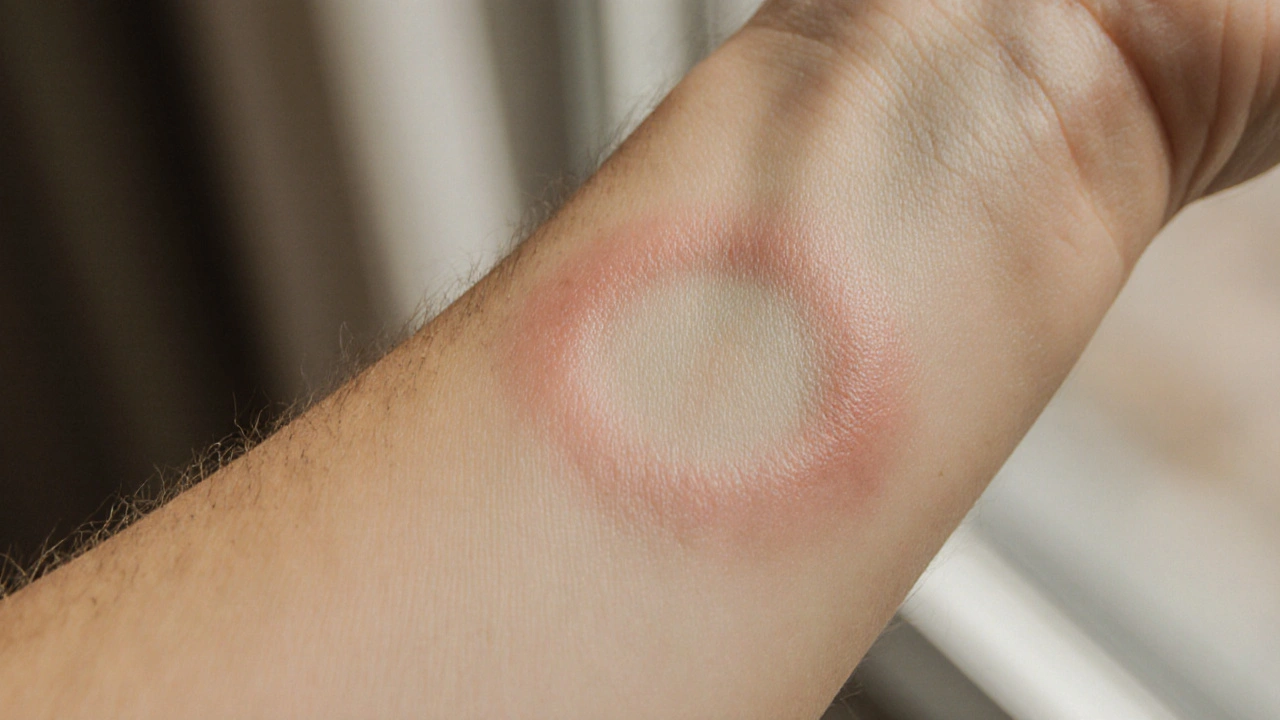Ringworm infection is a common fungal skin condition caused by dermatophytes that thrive on dead skin cells. It shows up as a red, scaly ring with a clearer center, and it can spread quickly if not treated properly. Knowing whether the infection is improving or deteriorating helps you avoid complications, reduces the risk of spreading, and saves you from unnecessary doctor visits.
Quick Take
- Improvement signs: reduced redness, less itch, shrinking ring, and smoother skin.
- Worsening signs: expanding ring, increasing pain or pus, new spots, or persistent itch.
- Track progress with photos, a symptom journal, and daily skin checks.
- Seek medical help if the rash spreads rapidly, looks infected, or doesn’t improve after 2 weeks of proper treatment.
What Is Ringworm, Really?
Despite its name, ringworm isn’t a worm at all. It’s a dermatophyte fungus that feeds on keratin, the protein in skin, hair, and nails. The most common types are Tinea corporis (body), Tinea pedis (feet), and Tinea cruris (groin). In healthy adults the fungus can be knocked out in 2-4 weeks with topical antifungal cream, but the timeline varies based on the strain, site, and how closely you follow the regimen.
Typical Healing Timeline
Most people see the first signs of improvement within 3-5 days of consistent treatment. The outer edge of the ring usually fades first, while the clear center may take a week or more to fully smooth out. Complete resolution can take up to 4 weeks, especially on thick skin areas like the soles or scalp. If you stop treatment early, the fungus can rebound, leading to the same or even a larger rash.
Signs Your Ringworm Is Getting Better
Watch for these positive cues:
- Reduced redness: The bright, inflamed border becomes pink or fades to your natural skin tone.
- Itchiness lessens: The constant urge to scratch drops noticeably.
- Ring shrinks: The outer edge recedes, and the clear center expands.
- Scaling dries out: Flaky skin becomes smoother and less noticeable.
- No new lesions: The infection stays confined to the original spot.
Warning Signs It’s Getting Worse
If any of these show up, you may need to adjust treatment or see a doctor:
- Expansion: The ring grows outward or new rings appear nearby.
- Increasing pain or burning: It goes beyond mild itch and feels tender.
- Pus or crusting: Yellowish discharge suggests a secondary bacterial infection.
- Persistent or worsening redness: The border stays bright red or becomes more inflamed.
- Swelling of surrounding tissue: Indicates the body’s immune response is kicking in.

How to Track Your Progress Effectively
The best way to spot subtle changes is to create a simple tracking routine:
- Take daily photos: Use the same lighting and distance. A side‑by‑side view after a week makes trends obvious.
- Write a symptom log: Note itch level (1‑10), pain, and any new spots each day.
- Measure the ring: Use a ruler or a disposable measuring tape to record the diameter of the outer edge.
- Check the medication schedule: Verify you’re applying the cream exactly as prescribed (usually twice daily).
When you compare week‑by‑week data, you’ll quickly see whether the infection is on a downward slope or climbing back up.
When to Call a Healthcare Professional
Most ringworm cases resolve with over‑the‑counter creams, but certain red flags demand professional input:
- No improvement after 14 days of correct topical use.
- Rapid spread to multiple body areas.
- Signs of secondary bacterial infection (pus, crust, fever).
- Immunocompromised individuals (e.g., diabetes, HIV) - they may need oral antifungals.
- Persistent itching that disrupts sleep or daily activities.
A doctor can confirm the diagnosis with a skin scrape, prescribe stronger oral medication, or advise on adjunct therapies like antihistamines for severe itch.
Common Pitfalls and How to Avoid Them
Even with the best intentions, people stumble over a few recurring mistakes:
- Stopping early: Feeling better after 5 days and quitting leads to relapse. Finish the full course, even if the skin looks clear.
- Applying too much cream: Over‑application doesn’t speed healing and can irritate skin.
- Missing hidden spots: Ringworm loves warm, moist areas like the groin or underarms. Check these places even if symptoms aren’t obvious.
- Sharing towels or clothing: Fungi survive on fabrics. Use separate towels until the infection clears.
- Using oily moisturizers underneath: Heavy ointments can create a breeding ground for fungus.
Quick Comparison: Healing vs. Worsening
| Indicator | Improving | Getting Worse |
|---|---|---|
| Redness | Fades, becomes pink | Remains bright red or intensifies |
| Itchiness | Decreases, less frequent scratching | Persistent, may become painful |
| Ring size | Diameter shrinks | Diameter expands or new rings appear |
| Skin texture | Scaling diminishes, skin smooths | More flaking, crusting, or pus |
| Overall feeling | Normal, no soreness | Burning, swelling, or fever |
Next Steps for a Smooth Recovery
Take these actions to keep the momentum going:
- Continue the prescribed antifungal regimen for the full duration.
- Maintain daily photo and symptom logs for at least two weeks after the rash clears.
- Wash bedding, towels, and clothing in hot water (≥60°C) weekly.
- Apply a light, non‑oil‑based moisturizer to prevent dryness, but avoid slathering the affected area.
- Schedule a follow‑up with your clinician if any worsening signs appear.

Frequently Asked Questions
Can I use over‑the‑counter cream for a severe ringworm infection?
Mild to moderate cases often respond to OTC options like clotrimazole or terbinafine. Severe or widespread infections may require prescription-strength creams or oral antifungals. If the rash covers a large area or isn’t improving after two weeks, see a doctor.
How long should I keep taking the cream after the rash looks clear?
Continue for at least 7‑10 days beyond visible clearance. This extra period kills any lingering fungi and reduces the chance of relapse.
Is it safe to exercise while I have ringworm?
You can exercise, but wear breathable, moisture‑wicking clothing and shower immediately after. Damp sweat creates a perfect environment for the fungus to spread.
Can pets give me ringworm?
Yes. Animals, especially cats and dogs, can carry dermatophytes. If you suspect a pet, have them examined by a vet and use separate bedding until cleared.
What’s the difference between ringworm and eczema?
Ringworm is a fungal infection with a clear‑centered ring and often a raised border. Eczema is an inflammatory skin condition that usually appears as red, dry, and itchy patches without the characteristic ring shape.


Maricia Harris
Wow, this reads like a soap opera for skin!